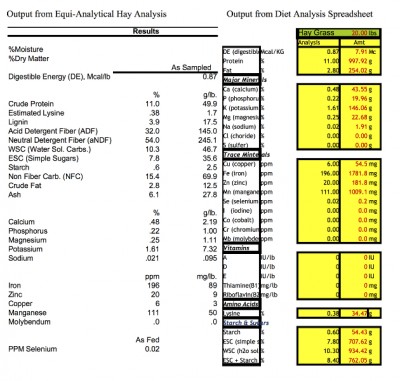Hay Analysis: What the output looks like
Above on the left is the relevant portion of the output provided you by Equi-Analytical for their (601) Equi-Tech hay analysis. For purposes of education I also added a test for Selenium (not part of the Equi-Tech analysis). I already know I live, and my hay comes from, a selenium deficient area of the United States (and Canada where this hay came from). On the right side is a portion of the spreadsheet I have for analyzing the diet in total,including all feeds and supplements. I’ve selected just the hay portion for the purposes of this post. It shows what 20lbs of hay/day provides the horse. 20lbs/9kg per day is what you would feed a 1000lb/454kg horse if feeding at 2% of desired body weight.
As you can note from the analysis on the right, this hay provides way too much Iron (Fe) and Manganese(Mn) at a gram each and not near enough Copper (Cu) or Zinc (Zn) to combat excessive uptake of those two potentially toxic minerals. How do I know there is too much Fe and Mn and not enough Cu or Zn? I’ve used the National Research Council Nutrient Requirements of Horses, 6th Edition to create my spreadsheet with modifications suggested by Dr. Eleanor Kellon VMD .
You can also note that 20lbs/9kg of hay only supplies 0.2mg of Selenium. Adult horses require between 2-3mg/day of Selenium. Lack of sufficient dietary Selenium can result in hoof and neuromuscular issues in the horse. Since Selenium can also be a toxic mineral, if in excess, it is important to understand what is dietarily required by the horse.
Dietary protein in this hay sample exceeds what is required by our 1000lb/454kg horse on a daily basis but that is not a problem. Excess protein is eliminated via the urinary trace. What is does mean is feed concentrates (grain) are not needed to supplement the hay for protein elevation purposes.
The final point I would like to make regarding this hay is that it is an excellent hay for horses which do not uptake and use sugar correctly. These types of horses are called IR (Insulin Resistant). I have two of those in my care right now. This is a mixed grass hay with little to no legume (clover or alfalfa) in it.

Jeannie: Are there any double blind control studies available telling whether or not hair analysis is an accurate way to determine current trace mineral, mineral and vitamin levels in horses?
Best Wishes
Bruce Peek
Hi Bruce: In short Hair Mineral Analysis is not a viable method for determining trace mineral, mineral and vitamins levels. The explanation of why you wouldn’t want to use this method is lengthly so I’d rather not go into it in a comment. If you want to understand more about that testing method and it’s short comings there is an article, online, in the Journal of Animal Science you can read: Mineral Concentrations in Hair as Indicators of Mineral Status: a Review
D. K. Combs, R. D. Goodrich and J. C. Meiske
Journal of Animal Science 1982 54: 2: 391-398
doi:10.2134/jas1982.542391x
Dr. Kellon also explains why as part of her NRC-PLUS online course.
Hope this helps. – Jeannie